If you ask a chef “how do you know when sausages are ready?” you’ll most likely receive a sarcastic response of “when they’re done”.
But what if you haven’t cooked thousands of sausages in your lifetime like many chefs?
Is there an easy way to know when sausages are ready?
The easiest, simplest and most consistent method is to use a digital thermometer. It’s as simple as inserting a temperature probe horizontally into the sausage and looking for an internal temperature of 160°F/71°C.
And if you think that relying on the colour of the cooked sausage meat is enough to know when your brats are safe to eat, you’re sadly mistaken.
More on that below plus key tips to consider for perfectly cooked sausages.

Why is the Internal Temperature For Sausages Different?
Ground meat generally needs to be cooked to higher temperatures compared to unopened cuts of meat like steak.
This is because ground meat has been aerated after grinding. [1]
Because there’s much more surface area from tiny pieces of ground meat compared to uncut steak, there’s also more chance of dangerous bacteria or pathogens getting inside.
So from a food safety standpoint, a steak is technically less risky to consume when cooked to medium rare than a burger cooked to medium rare.
The same principle applies to sausages, which contain aerated ground pork.
How to Tell When Sausages Are Done – The Best Method
The most accurate, consistent, no-fail method for knowing when sausages are done is to use a digital thermometer.
I’m not saying you have to use this method, it’s just the most accurate.
An accurate thermometer gives you peace of mind knowing that when food reaches this temperature, it’s out of the danger zone and a lot safer to consume.
When you use other methods such as the knife test or the pink test (more on that below), you still don’t know for sure that the meat is out of the danger zone.
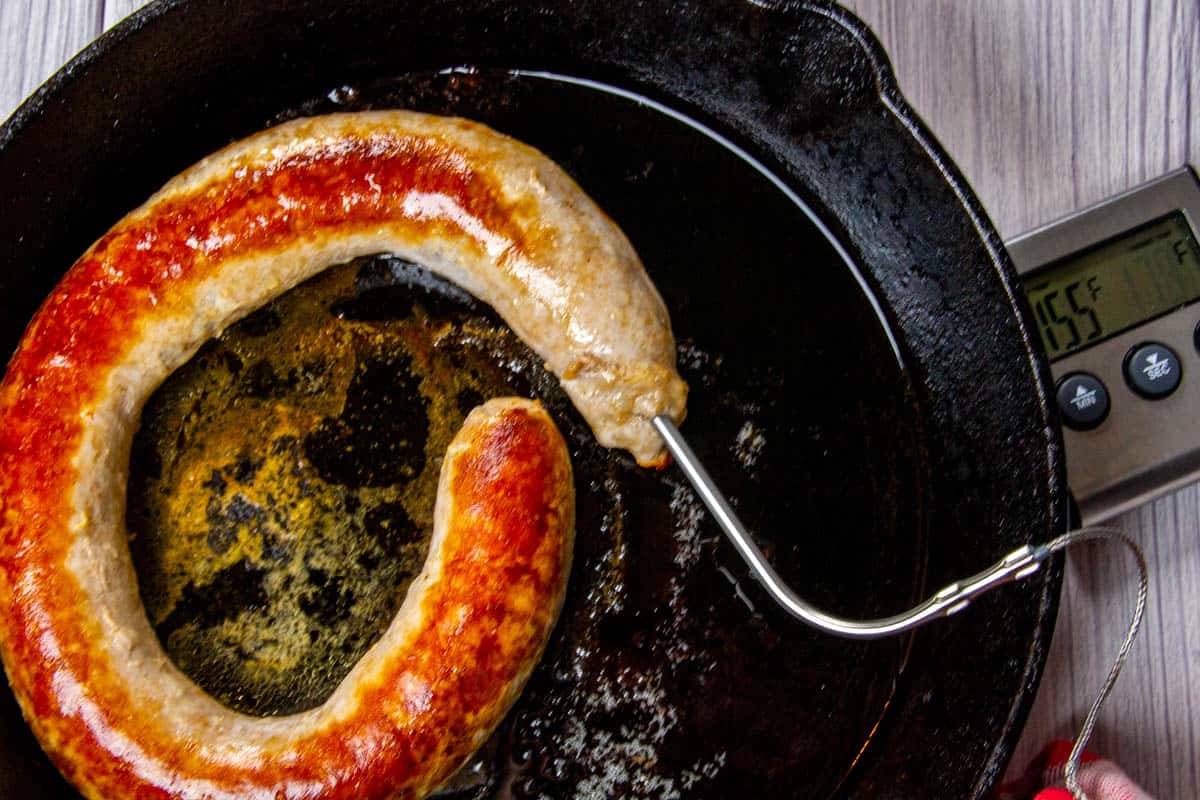
Here’s how to properly take the sausages’ temperature:
- First, make sure your thermometer is properly calibrated. To do that, fill a glass with ice and then fill it with water. Wait 5 minutes and then take the temperature with your thermometer. If it reads 32°F/0°C, then you know your thermometer is properly calibrated.
- Once you think your sausages are almost ready, insert the temperature probe into the middle part of the sausage horizontally. Once they reach 155°F/68°C they’re ready.
- Let the sausages rest for 5 minutes before eating.
Why the Pink Test Isn’t Very Reliable
Most people and their moms have probably heard about the pink meat test.
When meats such as chicken, turkey or pork are no longer pink inside, they’re considered done.
The problem with this test is that it’s not always true. [2]
For example, when some meat has been heavily brined or smoked before cooking, the meat may stay pink well over the desired cooking temperature (Hotdogs are a good example of meat that stays pink even after being cooked).
My advice for beginner cooks, especially when first starting out, is to always use a digital thermometer when cooking meat. It’s the only way you’ll know for sure when your meat is ready.
Sausages Doneness Temperature Chart in Celsius and Fahrenheit
Not all sausages will require the same cooking temperature.
I’ve created a handy little chart for the internal temperature of each type of sausage:
| Meat Type | Stop Cooking At | Final Temperature |
|---|---|---|
| Ground Pork | 160°F/71°C | |
| Ground Beef | 160°F/71°C | |
| Ground Chicken | 165°F/74°C | |
| Ground Turkey | 165°F/74°C | |
| Ground Game Poultry | 165°F/74°C |
The table above provides the estimated temperature to stop cooking medium-sized sausages. Rest the sausages for 3-5 minutes to allow the correct internal temperature to be reached.
Tips For Checking the Sausages’ Internal Temperature
- Insert the temperature probe horizontally instead of vertically. This way you’ll be much more likely to hit the center of the meat and get a more accurate reading.
- Give the thermometer 2-3 seconds to accurately read the temperature.
- Try not to check the sausage’s temperature too often. Added holes cause more juices to leak out and create drier sausages.
- If your sausage has a hole on the side of it already, use this instead of creating a new hole to prevent more juices from spilling out.
Why You Should Rest Your Sausages Before Slicing
It’s important to rest sausages for 3-5 minutes before slicing into them to prevent the hot juices from spilling out.
Rest your sausages in a warm place, preferably covered with a sheet of aluminum foil to keep them warm.
Resting the meat before slicing doesn’t “seal in the juices” or “allow the juices to travel inward” as some chefs incorrectly say.
What’s actually happening is that the meat juices are cooling down and thickening, thus reducing the speed at which juices leave the meat. [3]
Resting a sausage is even more important than resting a steak because a sausage is basically a meat water balloon.
When the casings break, most of the delicious fat and juices will leave, and you’ll end up with drier sausages.
What Temperature Should Sausages Be Cooked to With Carry-Over Cooking Factored In?
The recommended temperature for cooked ground pork sausages from the USDA Food Safety and Inspection Service is160°F/71°C. [1]
*BUT*, what they don’t tell you is that you need to also factor in carry-over cooking (Unless you enjoy overcooked meat).
Carry-over cooking is essentially the effect of residual heat left in food even after the heat is stopped.
Let’s say you’re cooking sausages on a grill and they’re almost ready.
As advised by USDA, you wait for your brats to reach an internal temperature of160°F/71°C and then pull them off the grill.
The problem is the sausages will actually continue to cook an extra 5-10 degrees even off the heat.
So you’re160°F/71°C sausages will actually be closer to165°F/74°C.
And the more you overcook the meat, the drier it becomes.
The solution for the juiciest meat is to always factor in carry-over cooking and remove your sausages about 5 degrees under your desired doneness.
So you should really be aiming to cook your sausages to155°F/68°C before pulling them off the grill and resting for 5 minutes.
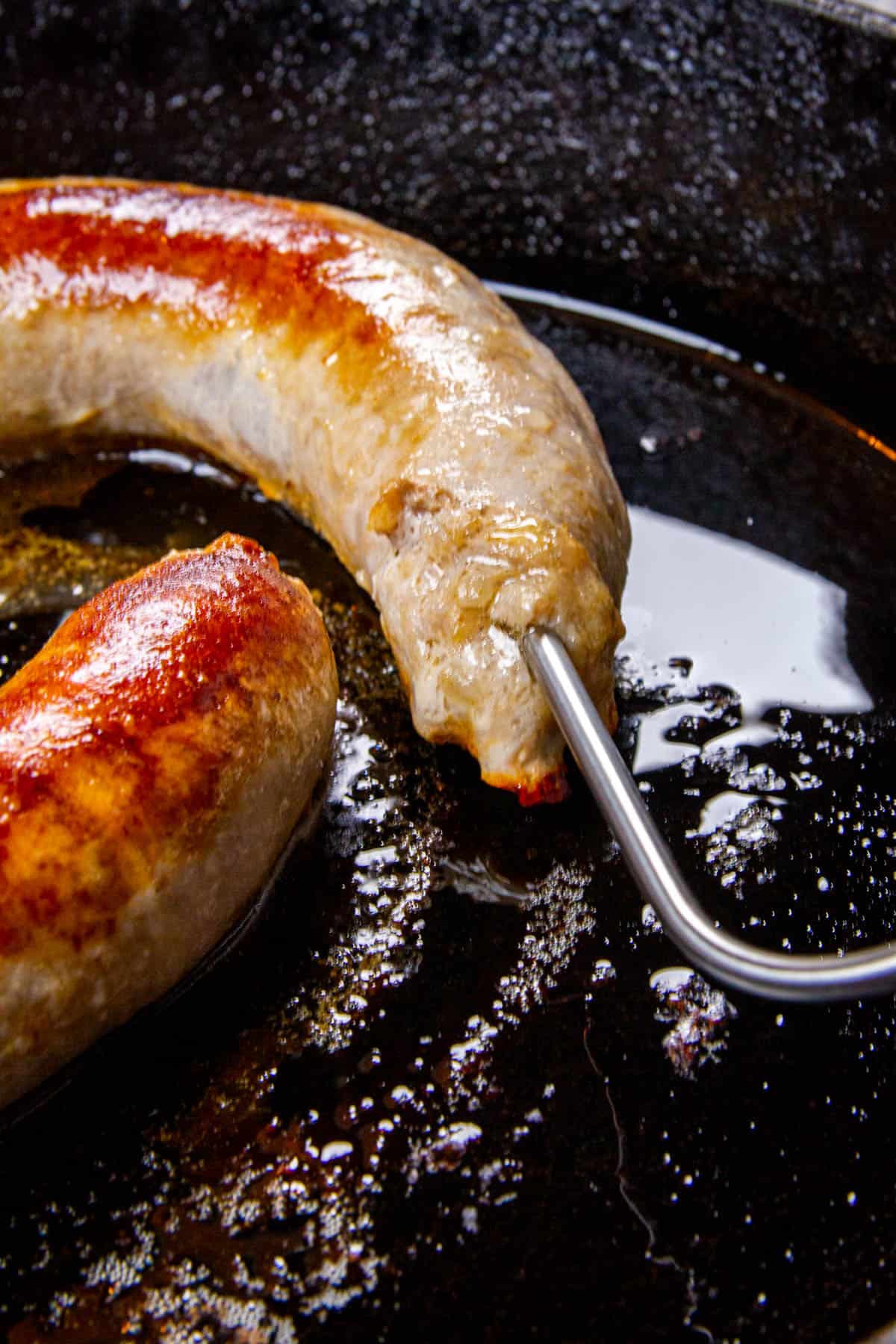
How to Pan-Fry and Roast Sausages
My favourite method for cooking sausages is to roast them using a cast iron pan.
Smaller sausages such as breakfast sausages can usually be finished directly in the pan. Larger brats like in my photos are better finished in an oven.
Here’s how to pan-fry and roast sausages:
- First, sear the sausages in a little oil to brown them nicely on each side.
- Then roast the sausages at about 375°F/190°C for about 10 minutes.
- Pull them from the oven once they reach 155°F/68°C and let them cool for about 5 minutes.
- Slice them and serve.
How to Poach Sausages
Poaching is another great technique for sausages.
The benefit of poaching sausages is that it’s a little bit faster than roasting but the downside is you miss the golden brown colour of searing and roasting.
Here’s how to poach sausages:
- Fill a wide pan with shallow sides about 3/4 full with salted water and bring to a boil.
- Drop the temperature to a simmer (not boiling) and add the sausages.
- Cook for 5-8 minutes or until internal temperature reaches 155°F/68°C.
- Rest for 5 minutes in a warm place.
- Slice and serve.
How to Grill Sausages
You can’t go wrong with some freshly grilled brats!
Here’s how I grill sausages:
- First, let your grill get quite hot. Give it a good clean to remove any dirt or carbon from the grill.
- Take a piece of paper towel and dip it in a little bit of high-smoke point oil. Rub a thin layer of this oil on the grill. Close the lid and let this burn off (this will prevent your sausages from sticking).
- Grill the sausages over medium-low heat, turning frequently to promote even cooking. Be careful not to break the casings as you move them around the grill.
- Once the internal temperature reaches 155°F/68°C, take them off the grill and let them rest for 5 minutes.
- Slice and serve.
Cooking Sausages FAQ
As described earlier, the colour of the meat is not a good indication of doneness. As long as the meat eventually reaches160°F/71°C, it’s considered safe to eat, regardless of the colour of the meat.
Some people like to prick sausages before cooking to prevent the casings from bursting. I disagree with this because the juices of the sausage are more likely to spill out after pricking.
Plus, if you’re grilling sausages, then that fat is going to spill out and create flare-ups that are more likely to burn your meat.
The solution: cook sausages low and low. A longer and lower heat reduces the chances of breaking the skin while still keeping the meat tender.
How to Cook Sausages Perfectly Every Time
Equipment
- 1 Digital thermometer
Ingredients
- fresh sausages
Instructions
- Preheat your oven to 190°C/375°F.
- Brown the sausages in a cast iron pan until golden brown on each side.

- Put the whole pan in the oven for about 10 minutes. Check the internal temperature of the sausages by inserting a digital thermometer horizontally into the sausage.Once the sausages reach 68°C/155°F remove them from the oven and let them rest for 5 minutes. The temperature will continue to rise to 160°F/71°C which is the desired safe temperature for pork sausages.

- Slice and enjoy!

More Guides to Try
- The Cutco Knife Set Reviewed + Better Alternatives
- 6 of My Favourite Cookbooks Right Now
- How I Solved My Lactose Intolerance – Lacto Freedom
- 6 Ways to Thicken ANY Sauce
- How to Season a Cast Iron Pan
Contents
- Why is the Internal Temperature For Sausages Different?
- How to Tell When Sausages Are Done – The Best Method
- Why the Pink Test Isn’t Very Reliable
- Sausages Doneness Temperature Chart in Celsius and Fahrenheit
- Tips For Checking the Sausages’ Internal Temperature
- Why You Should Rest Your Sausages Before Slicing
- What Temperature Should Sausages Be Cooked to With Carry-Over Cooking Factored In?
- How to Pan-Fry and Roast Sausages
- How to Poach Sausages
- How to Grill Sausages
- Cooking Sausages FAQ
- How to Cook Sausages Perfectly Every Time
- More Guides to Try


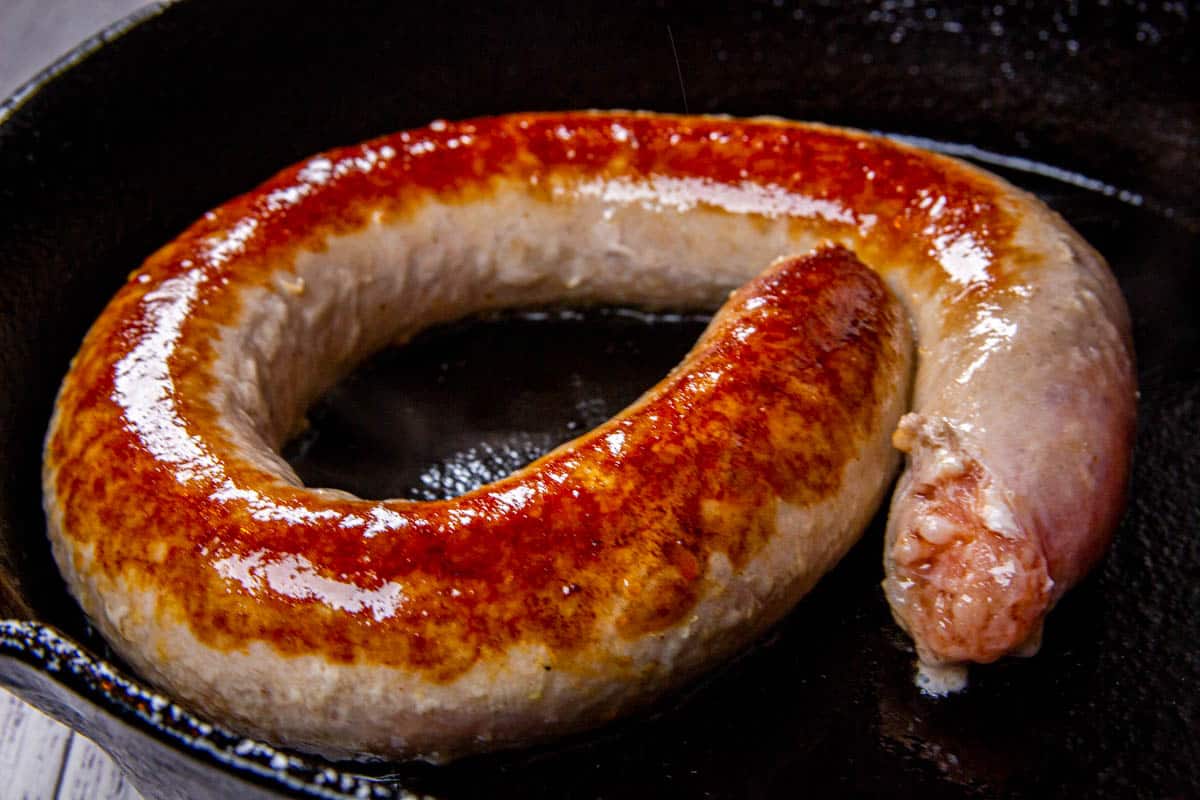
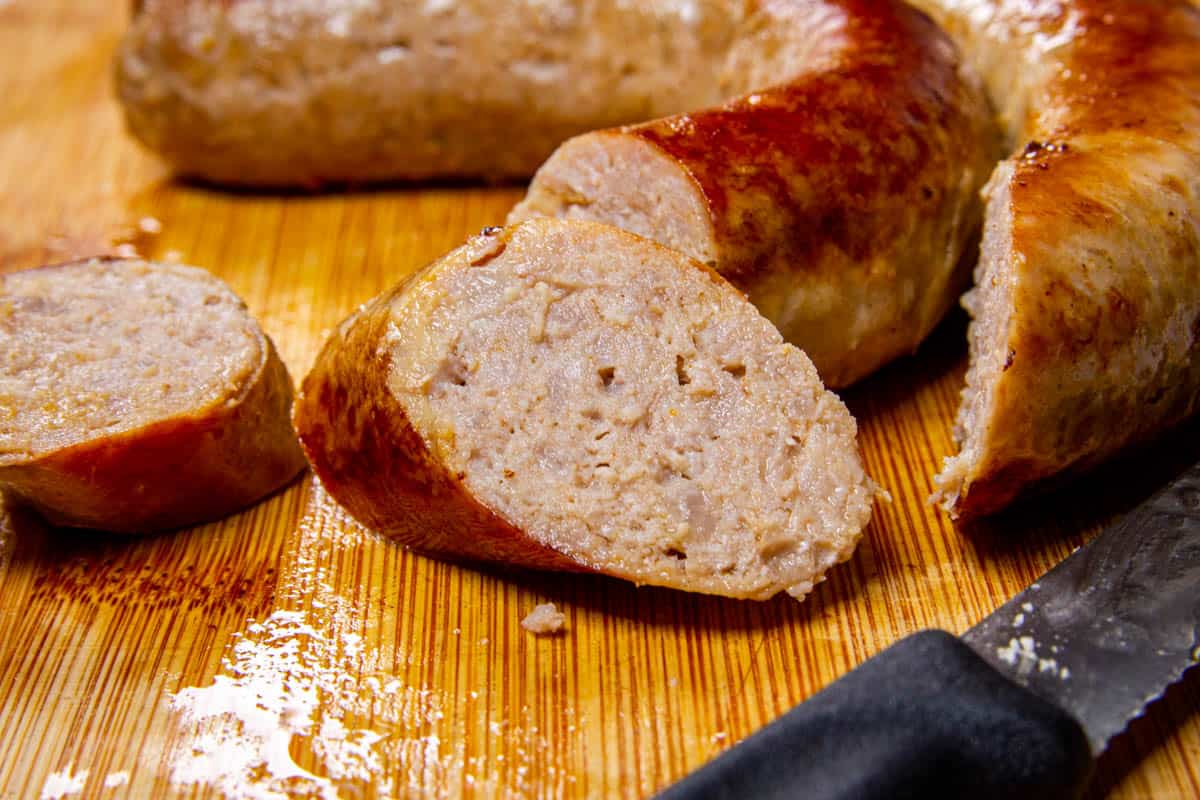
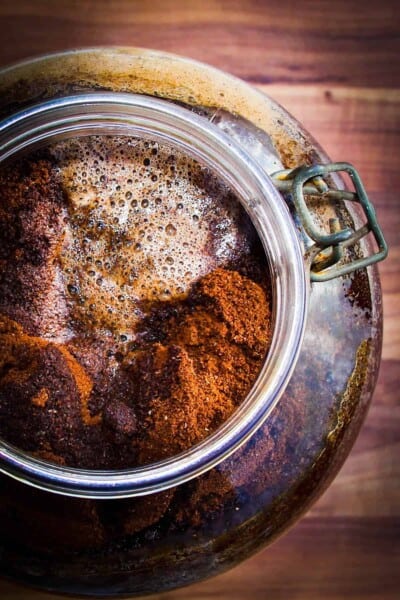


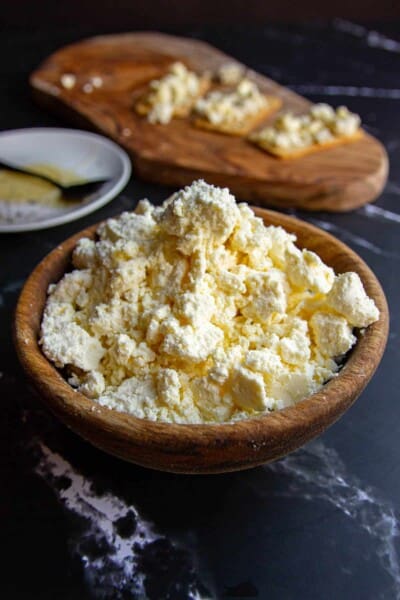
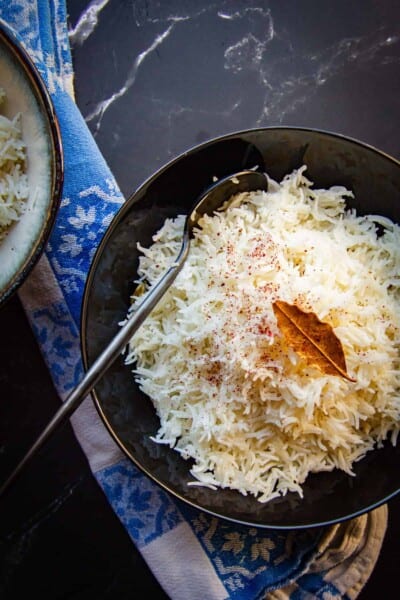
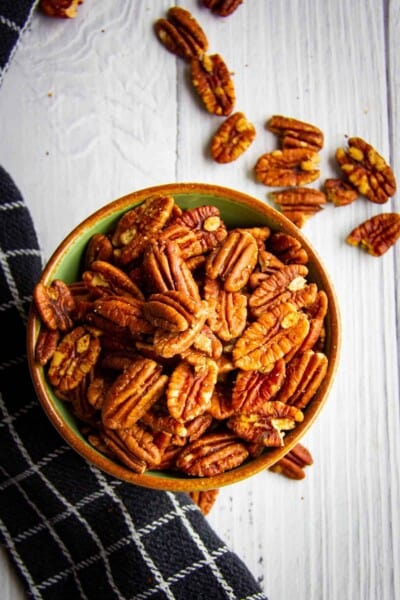
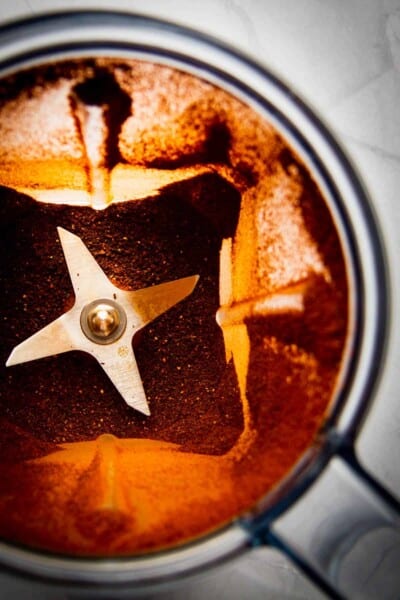


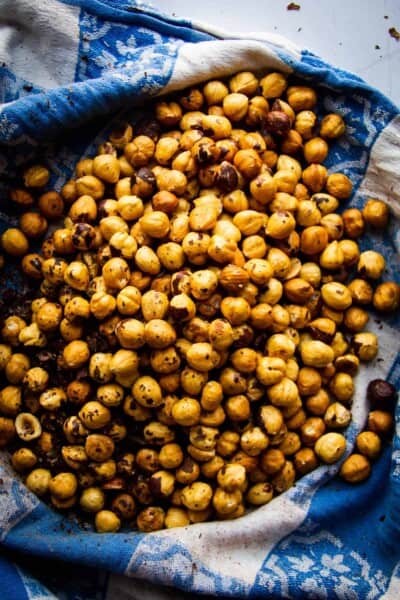
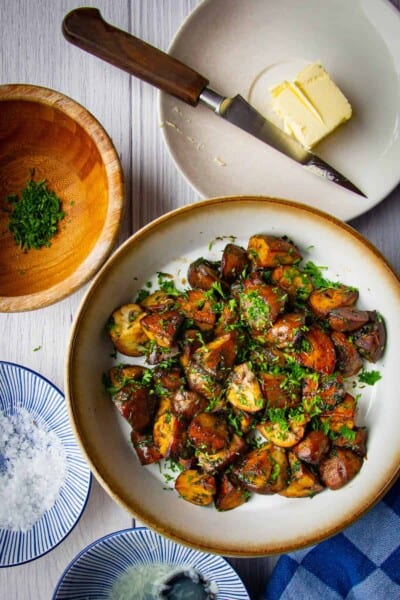
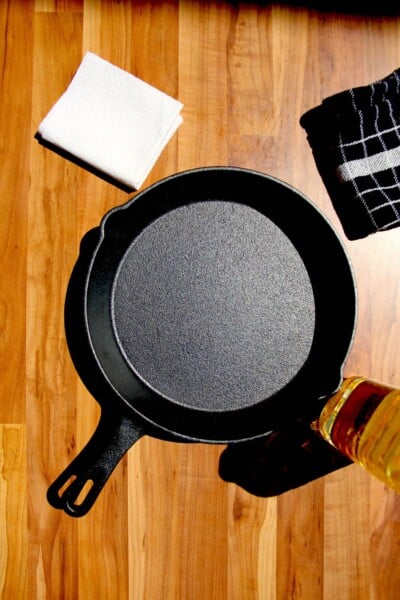
Great tips for cooking sausage correctly! I had correct temp but was measuring it vertically & horizontally would be more accurate. I also wasn’t allowing for rise in temp after cooking!!
I haven’t used a thermometer before and just relied on the color, but will start to use it now.
Have a question…I cut the Italian Sausages into large chunks before cooking them. Are they losing all their juices when cooked?